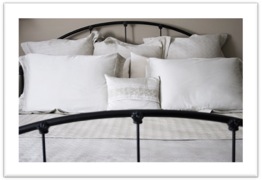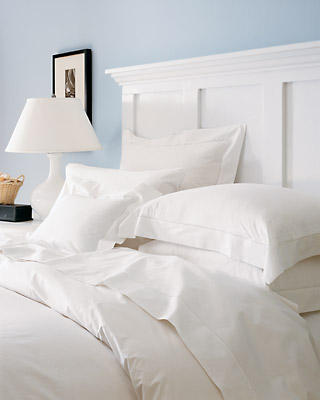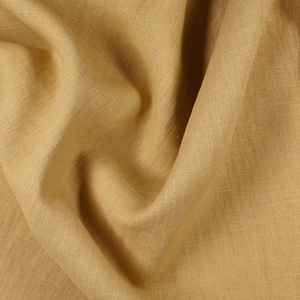Little Luxuries: How to Create Fine Linen Pillowcases
After waking up at the crack of dawn, dragging yourself to work and carting the kids off to soccer practice nothing is more inviting at the end of the day than a nice, cozy place to crash. But whether you get plenty of sleep or whether you are feeling a little sleep deprived, it is a scientific fact that you will spend over one third of your life asleep! So why not sleep in style with our do it yourself linen pillowcases perfect for catching some Z’s.
This project can be personalized any way you’d like’linen is ideal for hand embroidering or monogramming, and you can find a wide range of colors, so you can find just the fabric you need to match your décor.
Supplies
Linen Fabric: Using linen instead of the standard cotton elevates these pillowcases from a utilitarian item to a luxury one. Linen becomes soft and comfortable after the initial washing, and will add a touch of elegance to any bedroom.
You will need about one yard of fabric for each pillowcase you want to make.
Other supplies
“¢ Sewing machine and accessories (this project can be sewn by hand, but it will take longer to finish),
“¢ Yardstick and fabric marker or rotary cutter, ruler and mat
“¢ Scissors
“¢ Pins
“¢ Iron and pressing surface
“¢ Hand sewing needle and thread
Directions:
Note: This project uses a 1/2″ seam allowance. You will cut the fabrics, then assemble the pillowcase.
1. Cut out the fabric: Start out by measuring and cutting a piece of linen that is 43 inches wide x 30 inches long. It will look a little big at first but this will eventually make its way into a standard size pillowcase.
Tip: Use a rotary cutter and ruler to get the perfect cut every time. If you don’t have one, you can use a ruler and yardstick to measure your fabric, then cut with scissors.
2. Prepare to sew: Fold your fabric lengthwise so that the right sides are touching. (This means that the sides you want to “œshow” will be inside out.) Pin around three of the sides to ensure a straight sewing edge and help prevent the fabric from slipping.
3. Stitch the pillowcase: Sew together the three pinned sides of the pillowcase. The fastest way to do this is with a straight stitch on the sewing machine but this can also be done by hand if you have the patience.
4. Turn the pillowcase: Turn the pillowcase “œright side out” and press.
5. Hem the edges: Fold the hem of your case under ‘½ an inch and press. This will help keep the hem in place as you continue to the next step.
6. Finishing: Fold your hem once more, this time 4 inches under and press. Pin this hem in place, and sew by hand or machine to finish.
Next steps:
“¢ Finish off your pillowcase with a few fancy additions. Try adding a monogram, or use ribbons, lace and vintage buttons. Whatever you choose – just make it your own . . . your bedroom is the one place that should belong to you and only you so have fun with it!
“¢ A pair of luxury pillowcases makes a lovely gift’for an added touch, embroider with the recipient’s initials or monogram before assembling.
Don’t fight with the pillow, but lay down your head
And kick every worriment out of the bed.
~Edmund Vance Cooke














































13 Comments
Candy
The blog post says IL019 or middle weight. I made several sets for Christmas presents and used the left over pieces to make a couple for me. I love them. they are cool. I thought the coarse weave would be a problem but it is not, they feel very soothing to sleep on. I would suppose you could make them out of the lighter weight as well without a problem. Linen is lovely to sew on. I did french seams with mine but you could serge the edges or pink them.
The diagram shows sewing three sides and hemming the opening. I made mine with a separate cuff but will not do that next time as I think it would be more tidy to just fold in the hem and top stitch.
Tina Hennnig
Hi, I have the same questions that Lori had in 2010. Are you sewing across the fold?
Thanks, Tina
Ansie Bruwer
Hi, What weight linen fabric should one purchase to make pillowcases? What linen do you use for the sheets on the photo?
Thanks Ansie
silke Rowbal
I agree Joanna. There is no other fiber that performs like linen. I was amazed once wearing it on a long ride on horse back. We started in the morning on the valley floor where the temperature was around 100 degree and dry. We climbed several thousand feet and I found myself in the snow at approximately 8000feet several hours later, no around noon. The temperature was much, much lower up there, snow all around us. I had worn the same linen shirt without adding layers or take any off. Just one linen shirt on top. It kept me cool below and warm on the mountain top. I was in no discomfort at all. I felt energized, now was that the fresh air? Was it the linen? Was it being on horse back?? I dont know, but I certainly did not feel energy deprived. I know however if I had worn some sort of synthetic fiber or even cotton, it would not have worked out that way.
Anne G
I use the linen pillow cases I’ve made for years now. I finished the seams with French seams and hand hemstitched the hem. I have some lightweight, I think IL 20, for some new cases and will hemstitch by machine after French seaming. They also take embroidery really well and am considering making some nice, embroidered pillow cases for gifts. You have to iron them if you want them crisp. When they are new, them wrinkle badly. One trick is to dampen and put in a plastic bag in the refrigerator till they are cold. All the wrinkles come out that way. After using for a while, they are almost smooth if you don’t let them dry completely in the dryer, but take them out a little damp. I do the same thing for my heavy weight coverlet, lay it on the bed, smoothe it and it dries now smooth and soft.
christine boyle
I would recommend using the 3.5 oz for the pillowcases. I think it goes without saying to finish the seams because linen is notorious for fraying. You could use an overlock stitch, or the Hong Kong finish or even seam binding tape. I would refer to a chapter in your sewing book for this.
Remember to wash your fabric before cutting to factor in the initial shrinking amount. Linen gets better with use.
Happy Sewing!!
Joanna Patterson
I have not heard of “Linen rules” and did not know there was ever amy rules about when to wear linen. I wear it year round…always have. I have several long sleeve linen shirts and a couple of linen jackets. They are definately fall and winter as we never wear long sleeves here in the summer.
Linen is cool in the summer, and definately warm in the winter. I love it.
Joanna
Kitty
About the linen pillowcases, I’d say yes, the seams need finished. the linen I have is very prone to raveling. unless you’re using one inch seams, and even if you were, I’d finish them.
now as to weight that is a question I was interested in. I have IL19 and IL20 and both seem to coarse. I’ve gotten used to fine (many tiny threads per inch rather than a few coarser ones) fabrics for my pillow cases and just wrapping a piece of linen around my pillow to try this idea out it seemed hot and coarse. now I’m not sure which fabric I tried, but they just seem to coarse to me.
Lori
As far as weight of fabric, the link in the article where it says “about one yard of fabric” goes to the IL019/5.3 oz linen.
I was wondering about seam finishing too; and then a silly question, are you sewing across the fold when you sew the 3 sides together?
Debra
Maybe the 3.5 oz. Seems like I recall an article you posted regarding that wt. for this kind of project.
susan
no point telling us how to make a pillowcase without clarifying the correct weight of linen.
Bonnie
What weight linen fabric should one purchase to make pillowcases?
Barb
Love the idea of sleeping on a down filled pillow with a handmade linen pillowcase. Thank you for the instructions. But I have a question. Shouldn’t the seams be finished in some way to prevent fraying? French seams, pinked, etc? Just curious. Thanks.